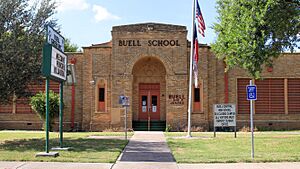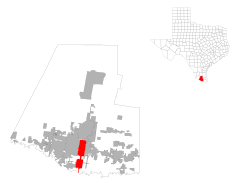Pharr, Texas facts for kids
Quick facts for kids
Pharr, Texas
|
||
|---|---|---|

The Buell School in Pharr, which was designated a Recorded Texas Historic Landmark in 1990.
|
||
|
||

Location of Pharr, Texas
|
||
| Country | ||
| State | ||
| County | Hidalgo | |
| Incorporated | February 22, 1916 | |
| Government | ||
| • Type | Council-manager | |
| Area | ||
| • Total | 23.65 sq mi (61.26 km2) | |
| • Land | 23.63 sq mi (61.19 km2) | |
| • Water | 0.03 sq mi (0.07 km2) | |
| Elevation | 112 ft (34 m) | |
| Population
(2020)
|
||
| • Total | 79,715 | |
| • Estimate
(2022)
|
80,187 | |
| • Density | 3,348.51/sq mi (1,292.85/km2) | |
| Time zone | UTC-6 (Central (CST)) | |
| • Summer (DST) | UTC-5 (CDT) | |
| ZIP code |
78577
|
|
| Area code(s) | 956 | |
| FIPS code | 48-57200 | |
| GNIS feature ID | 1343930 | |
Pharr is a city in Hidalgo County, Texas, United States. It is a suburb of McAllen, Texas. In 2020, about 79,715 people lived there. By 2022, the population was estimated to be around 80,187.
Pharr is connected to Reynosa, Tamaulipas, a city in Mexico, by a bridge. This makes Pharr an important place for trade and travel between the two countries. It is part of the larger McAllen–Edinburg–Mission and Reynosa–McAllen areas.
Contents
Geography of Pharr
Pharr is located in the southern part of Hidalgo County. It shares borders with several other cities. To the west is McAllen. To the north is Edinburg, which is the county seat. San Juan is to the east, and Hidalgo is to the southwest.
The city limits of Pharr stretch south to the Rio Grande river. This river forms the border with Mexico. The Pharr–Reynosa International Bridge crosses the Rio Grande here.
Pharr covers a total area of about 60.7 square kilometers (23.4 square miles). Only a very small part of this area, about 0.07 square kilometers (0.03 square miles), is covered by water.
- Las Milpas is a community that became part of Pharr in 1987.
History of Pharr
The city of Pharr was named after Henry Newton Pharr (1872-1966). He was a sugar planter and a businessman. In the early 1900s, Henry N. Pharr was involved with the Louisiana–Rio Grande Sugar Company. This company owned a lot of land.
In 1910, the town of Pharr was built on land owned by this company. Henry N. Pharr also ran for governor of Louisiana in 1908.
Pharr has grown a lot since the late 1900s. In 1990, its population was about 32,921. By 2019, it had grown to about 79,112 people.
In 1987, the nearby community of Las Milpas joined Pharr. In 2006, Pharr received the "All-America City Award". This award recognizes cities that work together to solve community problems.
Climate in Pharr
Pharr has a humid subtropical climate. This means it has hot, humid summers and mild winters. In January, the average high temperature is about 68°F (20°C). The average low is about 47°F (8°C).
In August, which is one of the hottest months, the average high temperature is around 100°F (38°C). The average low is about 80°F (27°C). The warm season lasts a long time, from June through September.
Pharr gets about 21 inches (53 cm) of rain each year. Most of the rain falls during the warmer months. September is usually the wettest month. This is because tropical storms and hurricanes can sometimes bring a lot of rain to the area. March is the driest month.
The highest temperature ever recorded in Pharr was 110°F (43°C). This happened twice, once in 1998 and again in 1999. The lowest temperature ever recorded was 13°F (-11°C) on January 12, 1962.
People and Population
| Historical population | |||
|---|---|---|---|
| Census | Pop. | %± | |
| 1920 | 1,565 | — | |
| 1930 | 3,225 | 106.1% | |
| 1940 | 4,784 | 48.3% | |
| 1950 | 8,690 | 81.6% | |
| 1960 | 14,106 | 62.3% | |
| 1970 | 15,829 | 12.2% | |
| 1980 | 21,381 | 35.1% | |
| 1990 | 32,921 | 54.0% | |
| 2000 | 46,660 | 41.7% | |
| 2010 | 70,400 | 50.9% | |
| 2020 | 79,715 | 13.2% | |
| U.S. Decennial Census | |||
In 2020, the city of Pharr had 79,715 people living there. There were 22,668 households and 18,420 families. Most of the people living in Pharr are of Hispanic or Latino background. About 94.33% of the population identified as Hispanic or Latino in the 2020 census.
Getting Around Pharr
Highways
Pharr has important highways that help people travel. I-2 and U.S. 83 are major roads that run east and west through the city. U.S. 281 runs north and south.
U.S. 281 meets I-2/U.S. 83 in the center of Pharr. It continues south to the Pharr–Reynosa International Bridge into Mexico. North of the city center, U.S. 281 is also known as I-69C.
Education in Pharr
Schools for Kids
Most students in Pharr attend schools in the Pharr-San Juan-Alamo Independent School District (PSJA ISD). This district has five high schools located in Pharr:
- PSJA North Early College High School
- PSJA Southwest Early College High School
- Thomas Jefferson TSTEM Early College High School
- PSJA Sonia M. Sotomayor Early College High School
- Buell Central DAEP
Some smaller parts of Pharr are served by the Hidalgo Independent School District or the Valley View Independent School District. Students can also apply to special magnet schools run by the South Texas Independent School District.
Colleges and Universities
For higher education, students in Pharr can attend:
Public Libraries
The Pharr Memorial Library serves the city. It provides books, computers, and other resources for residents.
Sister Cities
Pharr has "sister city" relationships with several cities in Mexico. These relationships help promote cultural and economic ties.
 San Luis Potosí, San Luis Potosí, Mexico
San Luis Potosí, San Luis Potosí, Mexico- Zacualpan de Amilpas, Tetela del Volcan, and Ocuituco, all in Morelos, Mexico.
Notable People from Pharr
Many interesting people have come from Pharr, including:
- Leo Araguz — a former professional football player (punter and kicker)
- Pedro Borbón — a relief pitcher in Major League Baseball
- Cali Carranza — a famous Tejano musician
- Carlos Diego Ferreira — a Brazilian mixed martial arts fighter
- Omar Ontiveros — a professional soccer player
- Baldemar Velasquez — a leader in labor unions
See also
 In Spanish: Pharr (Texas) para niños
In Spanish: Pharr (Texas) para niños


